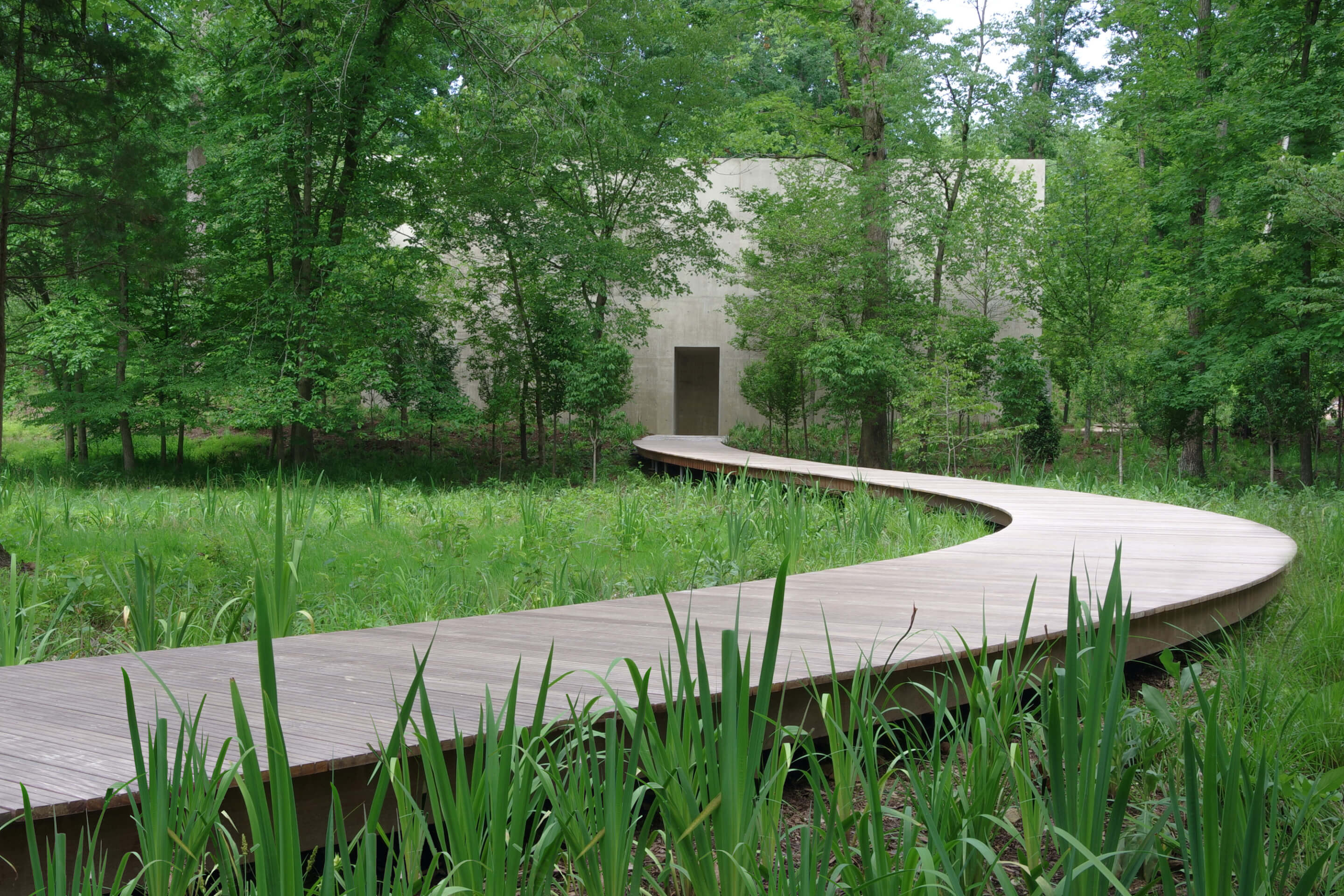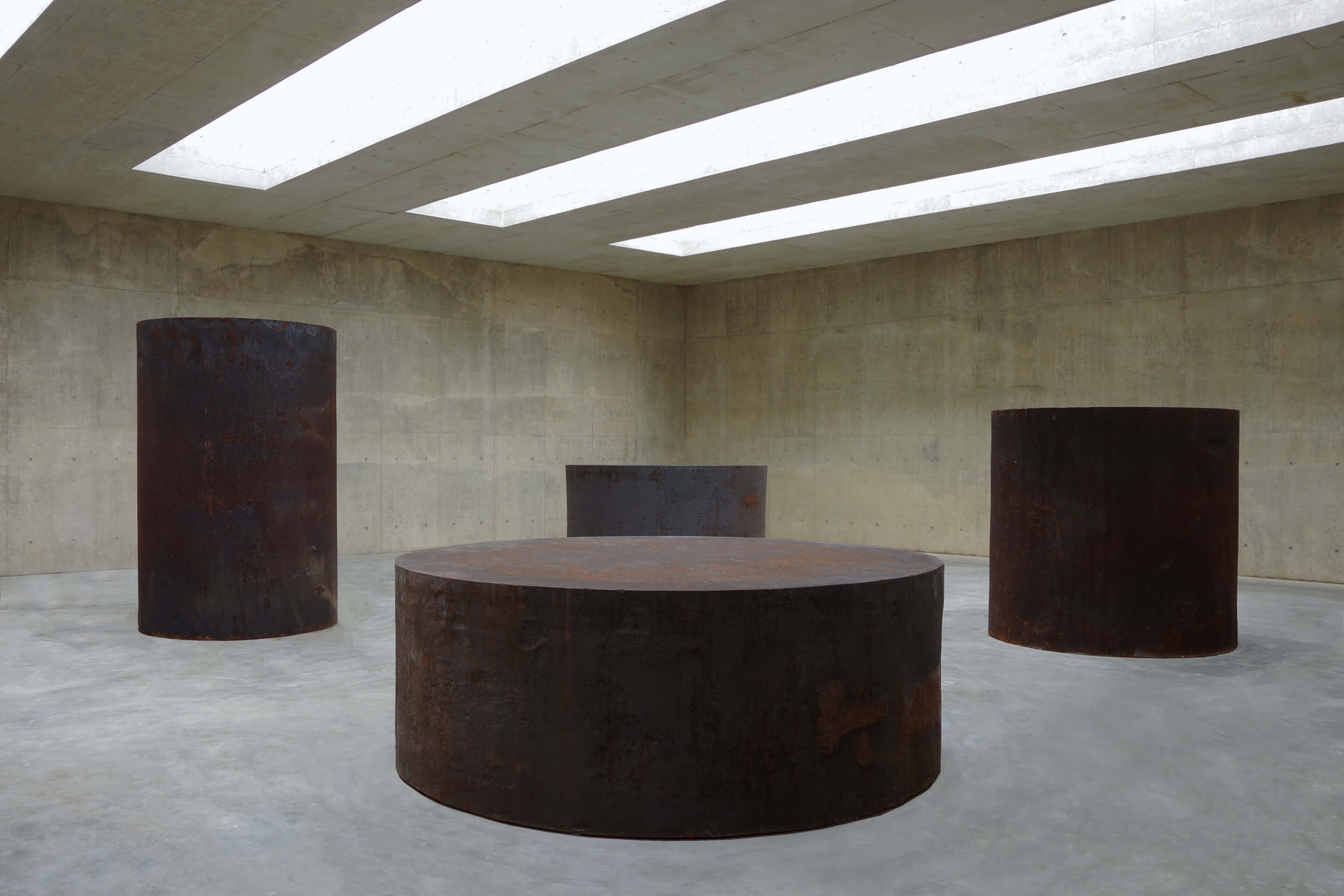It’s a short drive from the nation’s capital to Glenstone Museum in Potomac, Maryland, but you’re made to endure a few ungainly sights along the way. On either side of Piney Meetinghouse Road—and, to a lesser extent, Glen Road—mansions spring forth, each one more distended than the last. There are dispiriting exercises in Revival, Château, and Car Dealer Modern. A few head-scratchers defy Realtors’ stock taxonomy, their composite morphologies and bloated bearing recalling Ceaușescu more than cookie-cutter suburbia.
The haptic pleasures that populate Glenstone’s vast, publicly accessible grounds stand in stark contrast to this gaudy set. With its pruned forests and rolling hills punctuated by large sculpture and architectural follies, the 300-acre campus is a haven from wealth, built with exorbitant wealth.
After disembarking and checking in at the welcome center, you set out on the main promenade. Some minutes later, the Pavilions, a perfectionist’s ensemble courtesy of perfectionists Thomas Phifer and Partners, swing into view. But amble off the main path onto the branching trails, and you’ll stumble across grazing behemoths ascribed to equally weighty surnames. Koons. Heizer. Smith. Serra. So enamored are Glenstone founders Mitch Rales and Emily Wei Rales with the latter that they have acquired three of the octogenarian sculptor’s supersize steelworks.

Their most recent acquisition, Four Rounds: Equal Weight, Unequal Measure (2017), is housed in its own structure, purpose-built by Phifer in close consultation with Serra. This pavilion, a 4,000-square-foot concrete shed/shrine, is set deep into the campus, down in its treed lower reaches. The path to reach it meanders, purposefully, through a glade until connecting to a wayward boardwalk. (Its elegance is due to landscape architect Adam Greenspan, without whose efforts Glenstone would be a far less cohesive, enticing place.) You wend your way around trees and tall grasses to the sole entrance, recalibrating your sensory apparatus for what’s to come. “As you’re walking to it, you begin to cleanse, and to prepare yourself for the work,” Phifer told journalists at a June press event.
As its title suggests, the work consists of an uneven quartet of pieces that together explore themes of compression and difference. Serra’s stumpy cylinders clock in at 82 tons apiece, beyond which the forging process begins to flag and break down. Originally installed at David Zwirner’s West 20th Street gallery in New York, the steel drums were subsequently deposited in a New Jersey stockyard, where they remained, unsheltered, for some time. Within Phifer’s top-lit pillbox, the pieces regain their mystique. Daylight passing through angled glass diffusers imbues the space with an even brightness and glow, against which the heaving barrels stand in crisp relief. Their dark, patinated surfaces are revealed to be scratched, notched, dinged, blistered, soiled, abraded, flaking—unique micro-attributes that cumulatively speak to a material existence alien to our own.
When staged indoors, the impulse to frame Serra’s large-format sculptures in high contrast is an understandable inkling. (Born in San Francisco in 1938, the artist began making sculptures with lead in the late 1960s, moving on to sheet metal, Cor-ten, and finally, forged steel, indicating a steadfast interest in industrial grit.) But over his long career, Serra has developed an immunity to white-walled sedateness. “[He] lives in this world with his work in white Sheetrock spaces with perfect concrete floors, and he hates that,” said Phifer, who convened several design sessions with the elder artist. “He wants these spaces to have an authenticity to them, made in a symbiotic way to his work.”
Obligingly, Phifer’s building projects mass and texture. Reaching a depth of four feet, the floor slab was prepared and Four Rounds plonked down in advance of the superstructure, made from cast-in-place concrete. The walls are two feet thick; the beams overhead are six. Perpendicular seams and tie holes arrayed in a legible, gridded pattern invoke the serial side of Serra’s industrial approach, while the splotchy variegation of the concrete, ranging from desert reds to moody winter grays, speaks to the valences of durational experience. A keen sensitivity toward proportion emanates from all sides. Evidently, in their meetings Phifer would talk and talk, with Serra appearing to only half-listen. But finding moments of clarity, he would inveigh on details about the door frame or the dimensions of “the room,” which were set at 64 feet by 64 feet.

Serra’s hulking forms call out for subtending environments, including ostensibly “natural” ones. At Glenstone, the sturdy-but-pliant Contour 290 (2004) wiggles through a woodland. Meanwhile, the self-involved Sylvester (2001) is stationed on a lookout of the Raleses’ own bombastic home, designed, like the serviceable gallery nearby, by the late Charles Gwathmey. Four Rounds is a more delimited and thus circumspect work, requiring a bespoke architectural framework where its steely kin could unfurl or pirouette in open space. It’s tempting to imagine how the piece would work within the Pavilions, whose periscopic towers are bulwarks of introspection. Grouped around a reflecting pond, they mark out small and large galleries devoted to Cy Twombly, Simone Leigh, Brice Marden, and rotating exhibits. One walled, roofless quadrant offers a capacious setting for Michael Heizer’s Collapse (1967/2016), whose entropic frisson threatens to draw visitors down into its sunken pit. (Watchful staff and timed admission make sure that doesn’t happen.)
Scrupulous as the details of the Pavilions are, the immaculate, integrated setting doesn’t suit Serra’s purposes. By contrast, the new building hardly earns the appellation. Lacking mechanical systems or other moments of articulation, it is closer to a ruin, albeit one designed to endure. The same could be said of Serra’s ostentatious, though always supple, sculptures, whose physical mass is leavened by their almost mammalian gait and touching vulnerability to the elements. Keeping the long view in mind helps one understand a cryptic comment by Phifer: “You get a lot of this in Rome,” he said at the opening in June, before trailing off. Likely, he was alluding to the way the Pantheon, a totalizing work of architecture if there ever was one, makes itself tactically susceptible to the whims of storm clouds.
Phifer’s sylvan tempietto works with its environs as much as it does with Four Rounds. But however much of an impact the excursion to and from it has, the experience likely won’t put that thorny question out of mind: How much does all this cost? A figure hasn’t been divulged, fiscal discretion being important to the likes of the Rales. Regardless, the money has been spent, transmuted into forged steel and immovable concrete, which sit silent in the woods.
Design architect: Thomas Phifer and Partners
Architect of record: Thomas Phifer and Partners
Location: Potomac, Maryland
Landscape architect: PWP Landscape Architecture
Structural engineer: Skidmore, Owings, and Merrill, LLP
General contractor: Whiting-Turner
Geotechnical engineer: Schnabel
Engineering: DC
MEP engineer: Mueller Associates
Civil engineering: Vika
Lighting design: Arup
Signage/wayfinding: Gelberg Signs










